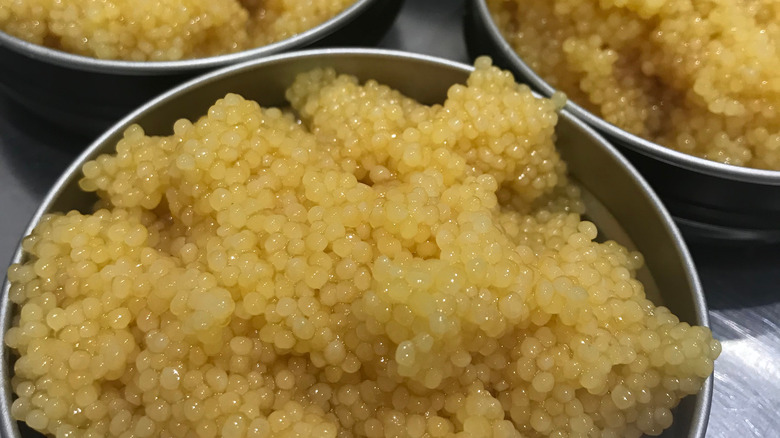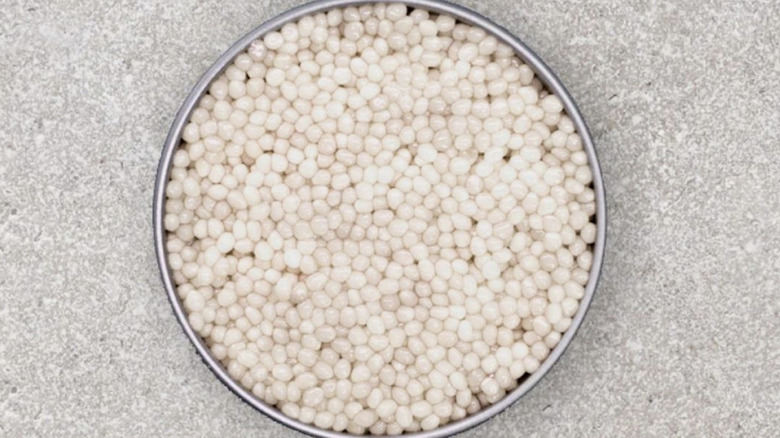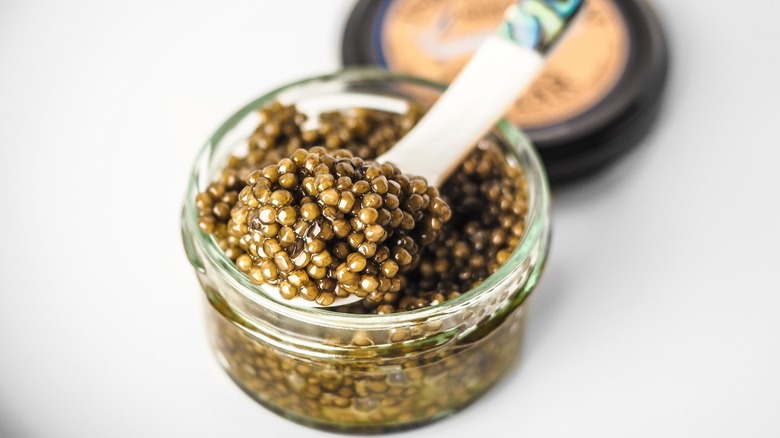Why Almas Is The Rarest Caviar In The World
We may receive a commission on purchases made from links.
If you've ever tried caviar — or have at least heard of it — you're likely aware that it's one of the world's most expensive foods. According to MasterClass, caviar is a term for unfertilized fish eggs, but it's important to note that true caviar should come from one of 29 species of sturgeon fish (white sturgeon, beluga sturgeon, and diamond sturgeon, for example).
House of Caviar reports that the large majority of the world's caviar is harvested from the Caspian Sea, which is nestled between southeastern Europe and western Asia. Most caviar today is farmed using techniques that ensure the quality of the fish eggs, such as a specific diet and the best possible living conditions. House of Caviar reports that tests are even run on the females who produce the eggs to ensure they are up to standard.
In general, caviar will always be a luxury meal. You might never find it cheap, but there are some types that are more expensive than others. If you're looking for Almas caviar, be prepared to shell out nearly $1,000 per ounce — here's why.
Why Almas caviar is so rare
Caviar as a category is expensive because it's hard to find, but this type of caviar is extremely rare due to the fish it comes from. Almas caviar is produced by the Iranian Beluga fish — even more specifically, one that has albinism, or a pigmentation condition, and is somewhere between 60 and 100 years old, per Imperia Caviar.
You'll have to shell out some serious cash to purchase these fish eggs. One kilogram (about 2.2 pounds) goes for nearly $34,000. Typically, caviar is served in one- or two-ounce servings, which means you'll pay up to $2,000 for about a tablespoon of the delicacy.
According to Azure Azure, the eggs have a slightly spongy texture and undergo a salting process that helps bring out the most in their creamy and nutty flavor. In terms of color, they have somewhere between a beige and white hue, and it can almost appear as if they are glowing. And if you somehow manage to get your hands on some of this coveted stuff, Azure Azure suggests eating your exorbitantly pricy bounty with blini or toast and a frosty glass of vodka or champagne.
But say you don't have an extra $34,000 in pocket change hiding in your couch cushions. What other kinds of caviar are available to you, a humble fish egg connoisseur?
How expensive are other caviars?
Most types of caviar don't cost anywhere near Almas, though it isn't exactly cheap to indulge in other varieties of these fish eggs. Still, there are options that, while expensive, are much more within reach. According to Caviar Russe, a website that provides caviar to consumers, Osetra caviar starts at around $165 per ounce. Gold Osetra caviar costs roughly $295 per ounce. Its distinguished gold tone sets it apart from other Osetra varieties, and as a result, it's more expensive; the platinum variety, on the other hand, costs a whopping $345 per ounce. Sevruga caviar is even more affordable; it costs $165 for 1.75 ounces at Caviar Russe. Other varieties, including Sterlet, Siberian, and Pacific caviar, all retail for somewhere in the low $100-range for 1.75 ounces.
Legacy French caviar purveyor Petrossian offers two kinds of Baika caviar for well under $100. According to the company's website, it's intensely briny and is the perfect accompaniment to "a summer by the sea."
Meanwhile, roe, by true standards, is not technically caviar because it does not come from the sturgeon fish. Instead, it commonly comes from salmon or trout, and as a result, its price is much lower than traditional caviar. It only costs about $10 per ounce.


